|
Between
1933 and the opening of the BBC’s Alexandra Palace
facility in 1936, the largest TV studios in Europe and
the most powerful television transmitters in the world
were not owned and operated by the BBC. They were situated
in a complex of buildings around the south end of the
Crystal Palace in Sydenham, South London – the home
of Baird Television Limited. Richard
Elen discovers that Independent Television
very nearly arrived 20 years early.
"The
existence of a fully equipped television broadcasting
station in the Crystal Palace, which could act at any
moment, was the great surprise which Mr J L Baird sprang
on the radio world yesterday..." - News Chronicle,
Saturday February 2, 1935.
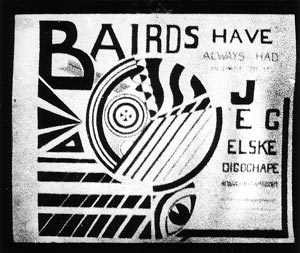 . .
"This
is a Baird Television transmission from their experimental
station at the Crystal Palace, London..." This
rather idiosyncratic test card (above,
courtesy of Ray Herbert) was used by Baird Television
Limited in their transmissions from Crystal Palace in
1934-6. It may have been accompanied by this
music - Louis Levy and the Gaumont British Symphony
playing "Music from the Movies - March", also
known, according to a recording deep in the Transdiffusion
vaults, as the "Baird
Television March" (MP3 file, 400K). The music
was also used for Gaumont British newsreels. The caption
below was seen at the beginning of the
film segment of test transmissions which made up the second
hour of the 1936 tests (see text).
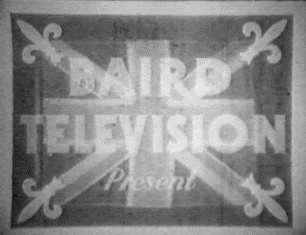
In mid-1932, around the time that the BBC began regular
30-line transmissions from Studio BB in the basement of
Broadcasting House (see Baird and the BBC, EMC,
February 2003), things had begun to change at Baird Television
Limited. In severe financial difficulties, control of
Baird's television company had, earlier that year, been
passed to a subsidiary of Gaumont-British Film Corporation,
controlled by Isidore Ostrer. The move, which had been
engineered by J L Baird’s business partner Sydney
Moseley in an effort to keep the company afloat, created
some consternation in the company, and a number of resignations
followed.
A
year later, in mid-1933, Baird was relieved of his duties
on the BTL board, although he retained the nominal title
of Managing Director. It seems that there was a feeling
that Baird had focused too much on mechanical scanning
and as a result there were only a couple of patents that
were of value to BTL. These would require thousands of
TV sets to be produced before they would yield income.
In addition, while Baird was seen as a visionary, practical
men on the board, such as the new Chairman Sir Harry Greer,
wanted to see results. There was even talk of a failed
merger with Marconi.
The
Move to Sydenham
Baird
moved into a house at number 3, Crescent Wood Road in
Sydenham, south London, where he was effectively banished,
albeit with access to some Company facilities, to his
own extensive laboratory. Here he was to work on new projects,
including large-screen television for cinemas owned by
the parent company, colour television and stereoscopic
TV. Just a short distance from the house was Joseph Paxton’s
Crystal Palace atop Sydenham Hill, where it had been reconstructed
after the Great Exhibition of 1851 in Hyde Park.
Baird
Television Limited moved from Long Acre to the Crystal
Palace in July 1933. Of particular interest to Baird,
BTL and their new technical director, former BBC and EMI
engineer Captain A D G West – and presumably the
main reason for moving there – was the southern of
the two water towers 1068 feet apart at either end of
the site. Built by Isambard Kingdom Brunel, the towers
were 275 feet high and afforded an extensive view for
miles around – and the South Tower was an ideal location
for VHF transmissions, which are essentially line-of-sight.
VHF or better is necessary to get the required bandwidth
for high-definition television images. Aerials at the
top of the tower, 680 feet above sea level and in sight
of seven counties, were installed to transmit high-resolution
pictures, and the company transferred its experimental
GPO licences from other locations. To avoid any potential
political problems, the GPO actually consulted the BBC
on the transfer: the BBC's Sir John Reith approved as
long as nothing was broadcast that looked like a public,
independent TV service. He was to be disappointed.
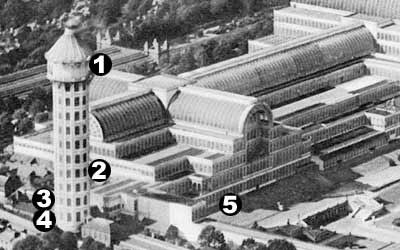
Above: South area
of the Crystal Palace site showing sections occupied by
BTL (after Herbert [1]).
1: Antennas for short-wave transmission,
South Tower (also see below).2: 2-metre
antenna (1938-9). 3: First floor: original
transmitter (1933) 4: Ground floor: colour
TV studio (1937-9) 5: Main studio, office
and lab area under south transept overlooking the terrace
(1933-6). Below: The entire complex from
the air (both images are from a mid-30s postcard, evidently
taken after the renovations of 1933 that left the towers
white).The Rotunda is in the far lower right and the School
of Arts is centre-bottom of the picture in the extreme
south-east wing (see text).
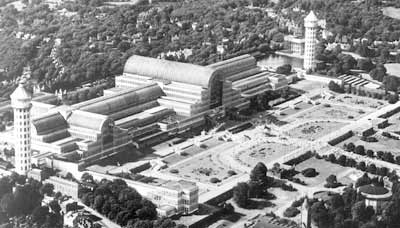
BTL
leased 40,000 square feet under the south transept, installing
offices, studios and laboratories, and a vision transmitter
on the first floor of the South Tower. Later the Rotunda
and space in the School of Arts were leased, bringing
the total space up to 60,000 square feet. Thanks to funding
from Gaumont-British, these facilities were extensive
and ultimately employed over 380 people - indeed they
were arguably more comprehensive in their capabilities
than the 1936 Baird installation for the BBC at Alexandra
Palace, which was no doubt built on the Crystal Palace
model. Unknown to most members of the public, there were
three full-size studios, the largest, Studio 1, being
60 x 40 feet in size, plus telecine and a small Spotlight
Studio for continuity. A central control room looked out
over all three main studios, with Studio 1’s Intermediate
Film camera on the floor below. The Intermediate Film
Technique used a cine camera and 17.5 mm film (split 35
mm), which was developed in just under a minute and scanned
with a flying spot.
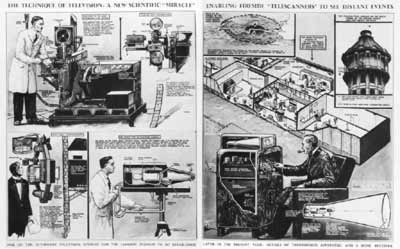
Click
on the image above to see a larger-scale
view of this double-page spread from
1935-6, showing the studio complex and technology (note: 100K
file)
On
September 12, 1933, Baird demonstrated 120-line, 25 frames
per second telecine equipment at the British Association’s
annual meeting, and later that month 120-line test transmissions
were made from Crystal Palace on wavelengths around 6.25
metres (48MHz).
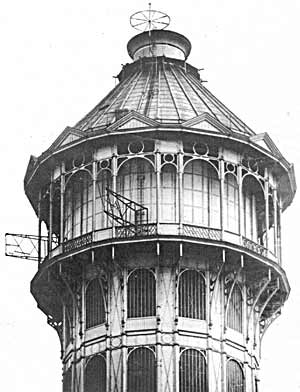
Above:
The top of the South Water Tower in 1935-6. The
antennae visible at the balcony level are for the original
6m sound and vision transmitters, while the assembly at
the very top is for the 1934 10kW VHF vision transmitter.
Below: close-up of one of the dipoles.
(Photos courtesy of Ray Herbert.)
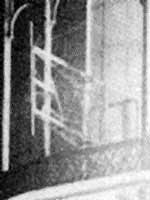
Public
Test Transmissions
In
contrast to EMI, who developed their system with a fair
degree of secrecy, the Baird company was very public about
its developments and missed no opportunity to invite Reith
to demonstrations, which he invariably failed to attend,
ostensibly to avoid being seen to favour one particular
manufacturer. He thus missed a presentation at Gaumont-British
offices in Film House, Wardour Street, at noon on March
12, 1934, where 180-line transmissions using both film
(telecine) and studio (Intermediate Film) sources
were shown on a receiver with no moving parts, employing
a cathode ray tube made under contract by GEC and showing
a picture (enlarged via a lens) of effectively about 12
x 18 inches. The vision signals originated from the 500-watt
transmitter at the Crystal Palace, with audio plus sync
sent by landline. BBC staff who attended noted that while
the picture quality was not outstanding, EMI at the time
was only offering telecine (with mechanical scanning),
and not "direct" (live) television.
A
further demonstration of the transmissions took place
at Wardour Street at the company AGM on March 20, where
Greer appeared on a large-screen TV live from Crystal
Palace. While Greer took a taxi back to central London,
the attendees watched a variety show.
At
this point, the Baird transmissions were mechanically
originated, either with the flying spot scanner or via
the Intermediate Film technique. However, BTL’s board
had made contact with Philo T. Farnsworth in the USA,
whose “Image Dissector” offered the possibility
of an all-electronic camera for the Baird system - but
unfortunately it needed a great deal of light and was
thus fine for telecine but not practical for studio use.
The agreement did, however, also make Farnsworth’s
magnetically deflected CRT available for Baird receivers.
A meeting took place at the GPO on 5 April, 1934, prompted
by Reith and attended by BBC and GPO staff, to discuss
“the future arrangements for the handling of television”,
in which the performance of Baird and EMI systems –
as well as some other technologies such as Scophony and
Cossor – were compared. The decision was taken to
appoint a committee to advise the Postmaster General on
matters concerning television. Following Parliamentary
assent, this was to become the Television Committee that
would be headed by Lord Selsdon: its first meeting was
held on May 29.
Independent
Television in 1934?
Also discussed were press releases from the Baird Company
in which it announced that it was preparing to approach
the GPO for a licence to begin an independent, high definition
television service. And in a letter to the Postmaster
General at the end of April, Baird director Major A G
Church noted, “…we are technically ready to
provide a programme of 180-line television from our station
at the Crystal Palace, to serve the whole of the Greater
London area.”[1] This was
no idle threat. In December 1934, a 10kW VHF transmitter
– the most powerful transmitter of its type in the
world – was installed next to Studio 3 in the Crystal
Palace building, close to the South Tower. It was capable,
according to a coverage drawing published in the Illustrated
London News in 1935 along with plans of the studios, of
serving the London area to a radius of 30 miles: a service
area extending to Maidenhead, Hatfield, Southend and Sevenoaks.
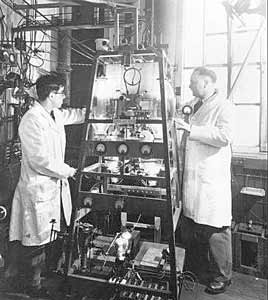
Above:
the original 500W transmitter included two 14in high Mullard
output valves, and relayed vision in 1933, sound after
the 10kW vision transmitter went on the air in 1935, and
finally colour images after the fire in 1936. The 1934
10kW vision transmitter (below) was an extremely advanced
design (see text).
(Photos
courtesy of Ray Herbert.)
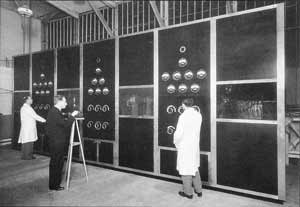
Ray
Herbert, an engineer at Crystal Palace from 1938, notes
that to avoid Marconi triode neutralising patents the
new transmitter featured Metropolitan Vickers Type 43
tetrode power output valves, which could be demounted
for maintenance, and were pumped continually to maintain
vacuum while in use. (The same valves, and very similar
transmitters, were used in the wartime Chain Home coastal
radar system; eight or nine former Baird employees moved
to radar at the start of the war and BTL was involved,
directly or indirectly, in the CH design.) The original
500-watt vision transmitter on the first floor of the
South Tower was to be used for sound and sync signals
on 35.3 MHz, while the 10kW transmitter was configured
to transmit vision on 42.8MHz. In early 1936, broadcasts
used 36 and 40 MHz respectively. The frequencies used
were fairly arbitrary, as the licence specified a broad
range and on any particular occasion the engineers simply
chose a frequency with no interference within the tuning
range of the antennae.
Baird
Transmits Alone
The Television Committee issued its report in late January
1935, proposing a high-definition VHF television service
to be operated alternately by BTL and Marconi-EMI, and
along with other political considerations, it is certainly
possible that Baird was included at least partially to
help discourage the company from carrying out its apparent
threat to go independent. Yet the very next day, surprised
reporters were shown around the Crystal Palace facility
and wrote extremely favourably about both the station
and the picture quality.
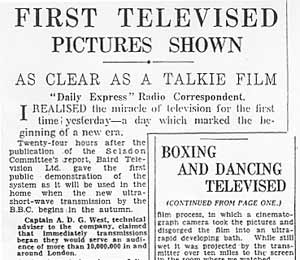
The
Daily Express of Saturday, February 2nd, 1935, (above)
along with several other papers such as the News
Chronicle (right), raved about Baird's Crystal Palace
facility. On February 1st, they and the newsreels
had been shown around the previously little-known
television facility – just a day after the
publication of the Selsdon Report. |
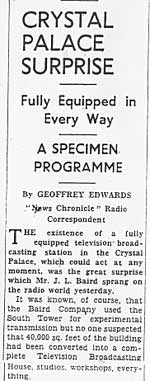 |
Geoffrey
Edwards, the News Chronicle Radio Correspondent,
wrote on Saturday, February 2, "Any search by the
BBC for a site for the promised London Television station
would, it seems, be a waste of time when the Crystal Palace
station is there ready for use." Baird Television
proceeded to underline this by transmitting a daily two-hour
programme of various types of entertainment. "We
could begin immediately," said Baird, brought in
from Crescent Wood Road to talk to the press, "a
service of high-definition television and synchronised
sound on ultra short waves for reception in homes throughout
the Greater London area." Independent television,
it seemed, might even beat the BBC to the punch.
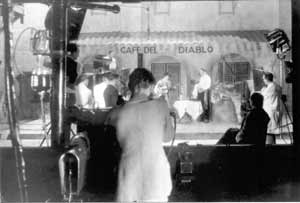
The
Café Del Diablo set in Studio 1, seen from behind
the Intermediate Film camera in the booth underneath the
central control room. The set was used for a number of
variety performances in 1935.
(Photo courtesy of Ray Herbert.)
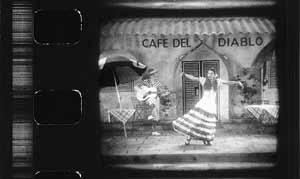
An
actual frame of 17.5mm Intermediate Film footage, of Doris
Sonne at the Café Del Diablo. Note the single row
of sprocket holes (it is split 35mm film) and the variable-density
soundtrack beyond them on the left to leave as much film
area as possible for the picture.
(Photo courtesy of Ray Herbert.)
Indeed,
in the period February to June 1935, over forty 180-line
demonstration transmissions were made from the Crystal
Palace. Says Herbert, "For important occasions, professional
performers were engaged. Alma Taylor made many return
visits; others included Doris Sonne (the dancer in the
Spanish sketches [these were broadcast from the 'Café
Del Diablo' set in Studio 1 - see photos above]),
Richard Hearne [later to be known as 'Mr Pastry'],
Leonard Henry, Vivian Foster ('the Vicar of Mirth') and
Claude Dampier with Billie Carlyle. The staff assisted
by providing boxing matches and carrying out announcing
duties." [2]
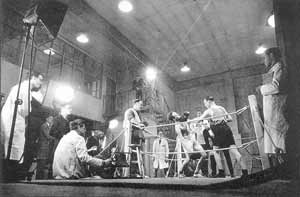
A
boxing match staged in Studio 1, looking from the floor
back towards the Intermediate Film booth and central control
room above. Referee and boxers were Baird Television Limited
employees.
(Photo courtesy of Ray Herbert)
Official
30-line transmissions continued until 11 September 1935,
but from then until transmissions began from the new BBC
site at Alexandra Palace in August the following year,
the Baird Crystal Palace facility, with the call sign
G2TV, was the only source of television broadcasts in
the UK. However, Herbert notes that after November 1935,
these primarily took the form of tests of the 240-line
equipment destined for Alexandra Palace.
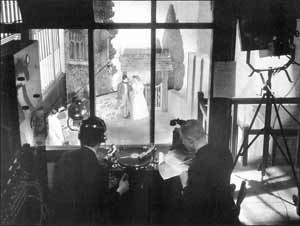
The
view from the central control room into Studio 3 (Photo
courtesy of Ray Herbert)
A
typical 2-hour test transmission consisted of an hour
of tuning signal and gramophone records followed by a
"talking picture transmission", broadcast at
3pm and repeated at 6pm. The transmission on February
22, 1936, for example, began, "This is a Baird
Television transmission from their experimental station
at the Crystal Palace, London. The Vision channel is operating
on a carrier frequency of 40 mega-cycles, or a wavelength
of 7.29 metres; and the Sound channel on a frequency of
36 mega-cycles, or a wavelength of 8.33 metres..."
It
was A D G West, rather than Baird, who led the team that
increased the system resolution while the company was
based at the Crystal Palace, and developed the 240-line,
25 frames system that was to be installed at Alexandra
Palace. It was demonstrated at the Press Club on 8 November
1935, where the Baird T5, the first of the new dual-standard
receivers that could receive both Baird 240-line and Marconi-EMI
405-line transmissions, was launched, showing images broadcast
from the Crystal Palace. The receivers – where the
real money was expected to be made in television –
were also built at Crystal Palace: in the School of Arts
adjacent and to the east of the main complex.
Studio
and transmitting equipment, essentially as developed for
the Crystal Palace facility, were delivered to the new
BBC station in March 1936, and transmissions from North
London began in August of that year. The BBC’s high
definition Television Service from Alexandra Palace was
launched officially on November 2, as has been recounted
elsewhere (See EMC, March 2003).
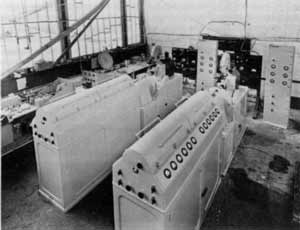
The design of the windows shows that
this shot of Baird telecine equipment was taken in the
Crystal Palace building, probably in 1935 or early 1936.
The equipment is either being readied for delivery to
Alexandra Palace or for the Baird station - probably the
former, as the Baird telecine booth was not near the windows
overlooking the terrace.
Less
than a month
after the launch at Alexandra Palace, disaster struck
in South London. On the evening of Monday, 30 November
1936, fire broke out in the Crystal Palace main building
and spread rapidly to engulf the majority of the site,
including the Baird facility. Of Baird’s operations,
only the South Tower, the School of Arts TV receiver plant
and the Rotunda in the grounds, where CRTs were made,
were spared. To add insult to devastation, on 16 December
the Television Advisory Committee meeting decided to abandon
the use of the Baird system in transmissions from Alexandra
Palace, and use the Marconi-EMI system alone.
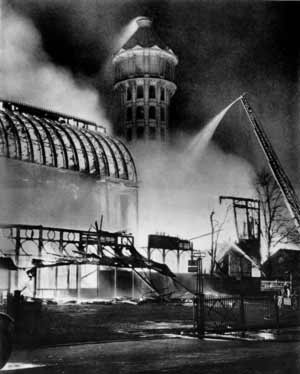
This famous shot of the later stages
of the fire [4]
shows the South Tower
beyond the still-burning shell of the main building
Work did not stop, however. The fire-damaged equipment
was covered by insurance, and the Baird Company went on
to install experimental Intermediate Film transmission
systems in military aircraft, along with developing large-screen
TV, plus colour television transmissions from the South
Tower, using the original 500W transmitter on 8.3 metres
(37 MHz) and a small studio on the ground floor of the
tower. There was also an experimental 200-watt 2-metre
antenna and transmitter at the fourth floor level. This
was used for 600-line transmissions (though generally
nothing more than field strength tests) for an ingenious
scheme. Gaumont-British intended to distribute their newsreels
by 2m television to their theatres, and hoped to be allowed
to break the BBC monopoly to run, essentially, the world's
first all-news television service. Unfortunately for them,
the war intervened.
Broadcasting
in Colour
Baird's
initial colour signals were generated from a 120-line
mirror-drum camera mounted on a trolley that made it possible
to take it outside the building. It was demonstrated,
first to the press in early December 1937 and then to
the public on 4 February 1938 at the Dominion Theatre
in London’s Tottenham Court Road, where 8-metre vision
transmissions from Crystal Palace were shown on a 12ft
x 9ft screen, the sound being carried by land-line.
Work continued at the Crystal Palace site until 1939,
with colour and large screen 8.3m, 2m and possibly 6.25m
405-line transmissions from the South Tower; CRT and transmitter
production in the Rotunda; and 400-line, 51MHz airborne
TV development for the French government in the School
of Arts.
With
the advent of war in September 1939, Gaumont British called
in a Receiver and put Baird Television Limited into liquidation.
Many members of staff lost their jobs, going on to work
on radar and at research establishments. And although
a new company, Cinema Television, was formed, Baird's
contract was terminated and his work continued largely
unaided until his death in 1946.
Baird’s colour system, by the end of 1940, was essentially
a development of the venerable flying-spot technology
that had been part of the Baird system from the beginning.
A high-power projection cathode ray tube was set up to
display a blank raster. The rapidly scanning beam was
passed through a rotating disc filter, half red-orange
and the other half blue-green, and then to a lens which
focused the scanning beam on the object being televised,
the reflected light from the object being picked up by
photocells. At the receiving end, the image was displayed
on a projection CRT behind a similar sychronised spinning
colour wheel, and through a lens to a screen for viewing.
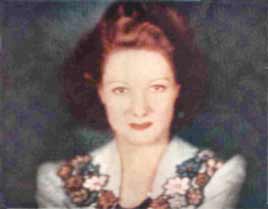
This image of aviator Paddy Naismith,
shot from the 600-line Baird colour display in 1940, was
printed in Electronics and
Television & Short-Wave World [5,6].
However, the printed version lacks the level of detail
shown above.
This
sequential-frame colour system was not unlike the colour
TV system developed by CBS in the United States after
the war, but in Baird’s case, the image was made
up of 600 scanning lines and was of impressive quality
(see above). Yet even this was superseded by the ingenious
all-electronic "Telechrome" system, for which
a receiver was first demonstrated to the press on 16 August
1944. And in 1941, Baird had refined the mechanical system
to transmit colour stereoscopic TV images using revolving
shutters and Red/Green/Blue sectored discs.
Sources:
This article would not have been possible without reference
to the following published sources:
1.
John Logie Baird – A Life, Antony Kamm and
Malcolm Baird, National Museums of Scotland Publishing
2.. Early Television at the Crystal Palace, Ray
Herbert, New Crystal Palace Matters, (Journal of the Crystal
Palace Foundation), Winter 1994.
3. John Logie Baird – A Pictorial Record of Early
Television Developments, 1924-1938, Kelly
Publications
4. Illustrated
London News
5. Electronic Engineering (formerly Electronics and Television
& Short-Wave World)
6.
Television History - the first 75 years
Thanks
also to Melvyn Harrison, Chairman of the Crystal Palace
Foundation, and the Crystal Palace Museum staff for their
assistance during my visit. In particular, my special
thanks to Ray Herbert for the use of his photographs,
press cuttings and his own articles, and helpful comments
without which this article would have been impossible
to write.
|